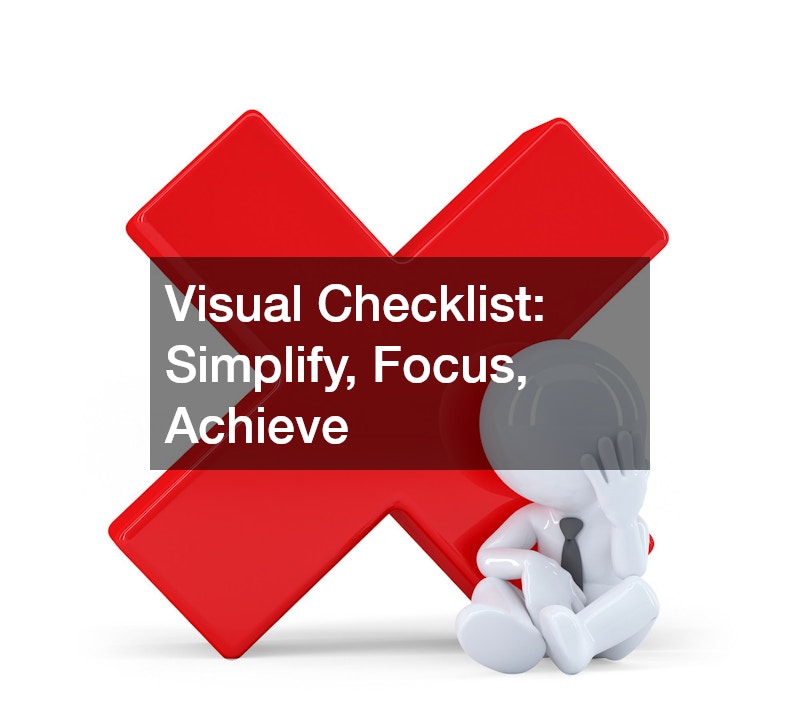In an era dominated by constant information overload and competing demands on our time, finding a method to cut through the noise and maintain clarity is more important than ever. The pace of modern life often leaves individuals feeling scattered, overwhelmed, or reactive rather than intentional. That’s why creating a system to simplify tasks, sharpen focus on what truly matters, and execute goals with precision is not just helpful—it’s essential. One of the most powerful and accessible tools to achieve this is the checklist.
Far more than a to-do list, a well-designed checklist is a strategic instrument that brings structure to chaos. It provides a visual, categorized framework that breaks down complex tasks into manageable steps, ensuring that nothing important slips through the cracks. By externalizing mental clutter into a clear format, checklists reduce decision fatigue, enhance memory recall, and offer a tangible sense of progress. They support not only productivity but also peace of mind, making it easier to stay organized, focused, and in control.
This article explores the transformative power of checklists in various areas of life, from maintaining physical and mental health to making informed consumer choices and managing day-to-day responsibilities. Whether you’re navigating health appointments, exploring personal style, or comparing care services, the structured approach of a visual checklist can simplify even the most intricate processes.
The content is thoughtfully structured to highlight how checklists can be tailored to diverse life areas. From accessing virtual mental health support to evaluating senior living communities, each section illustrates the versatility and adaptability of this tool. Whether you’re streamlining a wardrobe update or planning routine medical visits, a visual checklist becomes your reliable companion—keeping priorities in view and helping you stay on track. Let’s dive into how to harness this tool effectively, and use it to bring clarity, control, and confidence to your everyday life.
Access Virtual Help
Accessing virtual help has become increasingly important in today’s digital age, where a virtual therapist can provide mental health services from the comfort of your home. Incorporating a checklist can help you manage appointments, track progress, and organize therapy sessions. The clarity and organization provided by a checklist ensure you’re on top of your mental health management plan.
Specifically, when utilizing a virtual therapist, the checklist might include session dates, key discussion points, goals for therapy, and follow-up actions. It helps maintain a structured approach to mental health care, empowering you to engage proactively in your well-being. By visually tracking progress, you can easily see how far you’ve come and what areas still need focus.
Choose Women’s Wear

When shopping for womens clothing, having a visual checklist can make the process more efficient and enjoyable. It allows you to focus on specific needs, whether it’s for a particular occasion or everyday wear, ensuring you stay within budget and style objectives. A checklist can help prioritize items, highlight current wardrobe gaps, and avoid impulsive purchases.
In practice, your checklist might categorize items by necessity or occasion, such as office attire, casual wear, or evening dresses. It can also include color palettes, fabric preferences, and seasonal considerations. This organized approach not only saves time and money but ensures your wardrobe remains versatile and coordinated, consistently aligning with your personal style.
Visit Walk-In Care
At times, visiting a local walk in clinic is necessary for accessible medical attention without the wait for traditional appointments. A checklist can aid in preparing for such visits by listing symptoms, health concerns, and questions for the healthcare provider. This preparation ensures you address all health issues efficiently during your visit, optimizing the limited time you have.
Specifically, a checklist might include tracking current medications, noting any changes in health status, and recording past diagnoses or treatment responses. This organized method enables clear communication with healthcare professionals, ensuring they have all the necessary information to provide the best possible care. It’s a tool for both patients and providers to streamline health service delivery.
Treat Hair Loss

Experiencing hair loss can be both emotionally and physically challenging, often affecting self-esteem and overall well-being. For many individuals, addressing hair loss becomes a personal priority, requiring a proactive and organized approach. With a range of available treatments—ranging from over-the-counter products and prescription medications to specialized therapies—keeping track of what works, what doesn’t, and how consistently each method is followed is critical. This is where a visual checklist becomes a powerful ally.
A comprehensive checklist helps manage every aspect of a hair loss treatment plan by organizing treatment options, tracking application schedules, and logging follow-up appointments with specialists such as dermatologists or trichologists. It provides a structured routine, ensuring treatments are applied consistently and correctly, which is essential for optimal effectiveness. This visual approach minimizes missed doses or missteps that can hinder progress, helping to build sustainable habits.
More specifically, a well-designed checklist can be segmented into categories such as daily, weekly, and monthly tasks. These might include the application of topical treatments (like minoxidil), oral medication reminders (such as finasteride), scalp massage routines, dietary supplement intake, and scheduled laser therapy sessions. It can also include lifestyle factors—like hydration, nutrition, and stress levels—that play a role in hair health. Documenting physical changes over time, such as hair density, shedding patterns, and scalp condition, allows for objective tracking of progress, empowering individuals to make data-driven decisions about continuing, adjusting, or switching treatments.
In addition, the checklist fosters better communication with healthcare providers by offering a clear, visual summary of your treatment history and responses. This enables more informed discussions during appointments and supports personalized care. By taking the guesswork out of treatment and making routines more manageable, the checklist becomes more than just a planning tool—it becomes an essential part of a disciplined and hopeful journey toward improved hair health.
Manage Migraines
For those who suffer from migraines, managing triggers and treatment is crucial. Using a checklist to document migraine medication schedules, identify potential triggers, and log occurrences can greatly assist in managing this condition. It offers a clear overview of patterns, helping you and your healthcare provider craft a more effective management plan.
Specifically, your checklist might include medication names, dosages, timing, lifestyle factors like sleep and diet, and any external triggers like weather changes. You might also track pain intensity, duration of episodes, and any associated symptoms such as nausea or light sensitivity to capture a full picture of each migraine experience. By having this information readily available, it becomes easier to identify trends and adjust your management strategy accordingly. This proactive approach aids in reducing the frequency and severity of migraines, while also providing reassurance through a structured, self-monitored care system.
Find Autoimmune Aid

Managing autoimmune conditions requires careful attention to treatment schedules and health changes. Utilizing a visual checklist ensures you keep track of autoimmune treatment services, medications, and lifestyle adjustments. This organized system supports adherence to treatment plans and proactive management of symptoms, essential for maintaining quality of life.
Your checklist should include treatment milestones, medication schedules, diet and lifestyle changes, and regular check-ins with healthcare providers. You may also benefit from tracking symptom flare-ups, environmental triggers, and stress levels to better understand patterns and inform future care decisions. By having a comprehensive view of your treatment strategy, you can ensure no aspect is overlooked. This structured approach empowers you to manage your condition effectively, with a clear visual reminder of your goals and progress. Over time, this system can also serve as a personal health journal, offering valuable insights during medical reviews and enabling more tailored, effective care.
Try Chiropractic
Exploring chiropractic treatment can be beneficial for various musculoskeletal issues, promoting better physical health. A checklist can assist in tracking sessions, exercises, and progress, ensuring you stick to your chiropractic care plan. This method keeps your treatment organized, helping you achieve optimal results.
In terms of specifics, your checklist might include session dates, at-home exercises prescribed by your chiropractor, and symptoms or pain levels experienced. This detailed tracking allows for adjustments in your care plan as necessary, fostering a partnership between you and your chiropractor. With a focus on continuity of care, you can achieve better health outcomes over time.
Use Home Health

Incorporating local home health care services into a care plan can provide crucial support for individuals needing medical aid at home. A visual checklist helps manage appointments, medication schedules, and care routines, ensuring a seamless integration of services. This organization facilitates communication between caregivers and recipients, ensuring all care needs are met.
Specifically, your checklist could include a schedule of care provider visits, medication administration times, and health monitoring tasks. This thorough approach prevents oversight and ensures that all aspects of at-home care are coordinated effectively. By keeping track of services and responsibilities, you maintain a high standard of health care at home.
Explore Senior Care
Exploring a senior care service can be a complex process requiring careful consideration of available services. A checklists help compare different senior care service options based on criteria such as location, amenities, and costs. This approach ensures you find the best possible match for the senior’s needs while keeping all information clearly organized.
By detailing factors such as reputation, services offered, and reviews on your checklist, you can effectively evaluate and compare different service providers. This thorough evaluation process ensures informed decision-making, prioritizing the well-being and comfort of the senior involved. A visual checklist transforms the complexity of choice into an organized decision-making process.
Compare Assisted Living
Finding the right assisted living communities requires a comparison of multiple factors, making a visual checklist essential for an organized search. This tool helps you systematically evaluate facilities based on environment, care options, and the overall quality of life they offer. A structured comparison aids in confidently choosing the most suitable community.
Specifically, your checklist might include details such as staff qualifications, recreational activities, and accommodation styles. Incorporating these details into a comprehensive visual format allows for quicker, more informed decisions. By simplifying this complex search process, a visual checklist serves as an invaluable tool in finding the ideal living arrangement for yourself or a loved one.
The power of a visual checklist lies not just in its simplicity but in its profound ability to bring order to the chaos of modern life. In an age where multitasking is often celebrated yet mentally exhausting, checklists offer a calming counterbalance, streamlining goals, clarifying intentions, and helping us take deliberate action. Whether you’re managing a health regimen, coordinating household responsibilities, or making thoughtful personal choices, a visual checklist serves as both a compass and a roadmap. It turns scattered thoughts into structured tasks, making even the most complex processes approachable and achievable.
Throughout this article, we’ve explored how the humble checklist transcends its traditional function. It becomes a tailored tool—one that adapts to specific life areas such as accessing virtual therapy, planning wardrobe purchases, managing chronic conditions, or comparing elder care options. In each case, the checklist transforms ambition into action, offering both oversight and insight. Its visual nature enhances engagement, making it easier to stay motivated and monitor progress at a glance. Each category-focused checklist becomes a step-by-step guide designed to remove overwhelm, reduce forgetfulness, and increase follow-through.
More than just a productivity hack, checklists represent intentional living. They enable us to cut through distractions and direct energy toward meaningful goals. As personal and professional lives grow increasingly intertwined and demands continue to evolve, the ability to prioritize effectively becomes critical. Checklists empower us to do exactly that—allowing for flexibility while maintaining structure. They serve as a form of self-leadership, helping us take control of our time, health, and resources with clarity and confidence.
Ultimately, the visual checklist is not only a tool for achieving more but for living better. It simplifies decision-making, supports consistency, and fosters a sense of accomplishment through visible progress. By committing to the use of thoughtfully designed checklists, individuals gain a practical system for aligning actions with intentions. Embrace this transformative approach to stay focused, organized, and purpose-driven—no matter what life throws your way.




